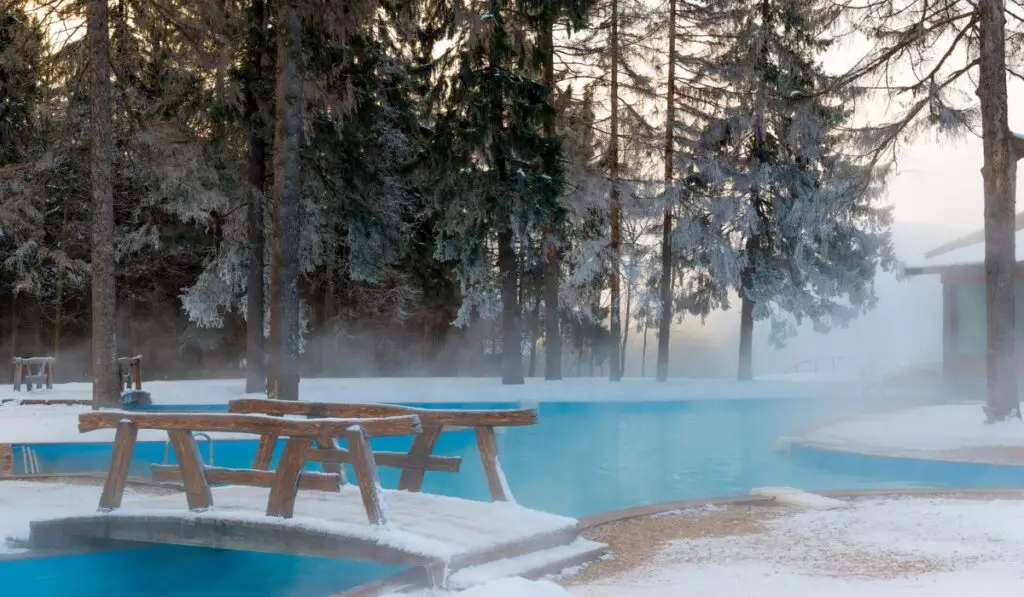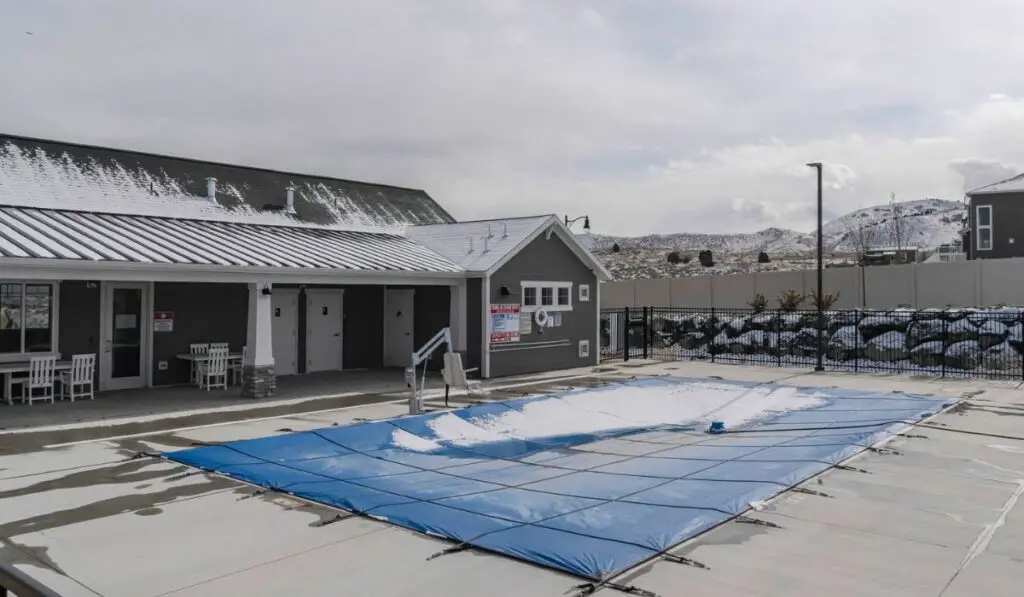If it’s winter and your pool is suffering from a sheet of tough ice on top — or worse, deeper than a sheet —you might be wondering if pool salt can melt it. After all, you need a quick and convenient way to melt the ice and get the pool back back to normal.
Pool salt can melt ice in the pool or elsewhere on your property. However, the salt won’t do anything if the ambient temperature is below 0°F/-17°C. You can prevent ice from forming in your pool by using a cover, running the heat pump, maintaining water levels, and using pool anti-freeze.
Let’s take a closer look at how to use pool salt to melt ice, as well as the advantages of doing so and some other methods you can use to melt ice.
How Does Salt Melt Ice?

Salt lowers the freezing point of water as it dissolves. For that reason, when you put salt on ice, it actually acts on the liquid water that sits on the surface of the ice, lowering its freezing point.
Then, as ice comes into contact with this salty water, it melts, creating more liquid water. The salt continues to dissolve, and more ice melts in turn, forming a neat cycle that continues until the ice is gone. Ta-da!
Will Pool Salt Melt Ice?
Pool salt works the same way as any other salt, so yes, it will do its part to melt ice down into water! It might take some time and isn’t the fastest method, but it will definitely be effective and is therefore worth trying.
However, you have to make sure the temperature outside is still above 0 degrees Fahrenheit. If it’s not, the salt won’t be able work its magic.
As long as it’s above 0 degrees, you can use salt for ice on the pool, your car, or basically anywhere, without the risk of damage.
Is Pool Salt the Same as Rock Salt?
Pool salt is basically the same as rock salt and has the same purpose. The main difference is that pool salt comes in larger quantities, like this 40-pound bag (on Amazon), since it’s intended to cover bigger areas and do a larger job.
How to Properly Use Pool Salt to Melt Ice
You should apply the pool salt in thin layers to the ice. There’s no need to go overboard, as a thin layer will start to melt the ice right away.
Where you can, wipe the saltwater away as it melts because you may not want a lot of it getting in the pool — but don’t worry too much for now.
Take things slow and be consistent, and make sure the temperature is high enough that this method will actually work.
Other Ways to Melt Ice
If you don’t have pool salt handy or are just looking for other possible ways to melt the ice, here are some options:
Homemade Hot Water Mixture
Combine a half-gallon of hot water with a quarter cup of rubbing alcohol and a few drops of dish soap. Gently pour this over ice on the driveway or the ground and it should bubble up and melt away.
This may not be the best option for ice in the pool, as you don’t want to pour rubbing alcohol into water that you then plan to swim in later — and you may seriously throw off the chemical balance.
Snow-Melting Mats
You can buy reusable snow-melting mats (on Amazon) that will quickly melt snow and ice. Simply throw them over the ice that’s formed on steps or your driveway, plug them in, and they’ll heat up to melt it.
The advantage to these mats is that they don’t need to be above a certain temperature, as the mats will create the warmth necessary.
Fertilizer
If you have some fertilizer handy but no salt, you may be surprised to know this can also do the job for you. Fertilizer won’t work as quickly as salt or heated mats, but it usually has the chemicals necessary to get rid of the snow and ice if you aren’t in a rush. Again, this may not be the best option for your pool water though!
Heat Pump
If you’re more interested in melting the ice in your pool than elsewhere on your property, then the best way to do so is by running your pool’s heat pump (if it has one). This only works if the sheet that has formed on top of the pool is around a quarter of an inch thick or less.
Gently break up the ice on top of the pool, making sure to remove your pool cover so it doesn’t get damaged by jagged edges. Once you’ve done that, let the heat pump run. The pieces of broken ice should dissolve into the water.
How to Prevent Ice From Forming on Your Pool

If it’s ice on the pool you’re worried about, there are a few ways you can try to prevent it from forming in the first place:
- Use a pool cover to keep heat in
- Break up any sheets of ice constantly to prevent them from becoming thicker
- Keep your heat pump running so that the water doesn’t get too cold
- Maintain the proper water level and don’t let it get too high
- Use pool-specific anti-freeze (on Amazon)
While a thin sheet of ice on top of your pool is usually no big deal, thicker sheets can definitely damage the structure and equipment — and they can be a nightmare to get rid of. Being preventative is key.
Overall, there are a few great ways to melt ice quickly and effectively. While you have several options for on your driveway or outside steps, the choices for pool ice are a bit more limited.
Pool salt is a great way to do it, and taking preventative measures can help you avoid a repeat situation in the future. Just make sure you keep an eye on the pool, even when it’s closed for the winter.
